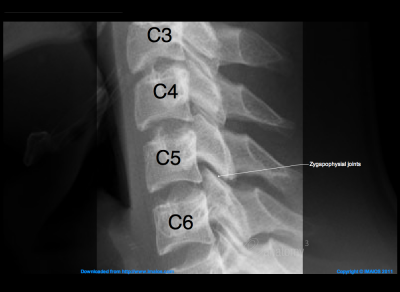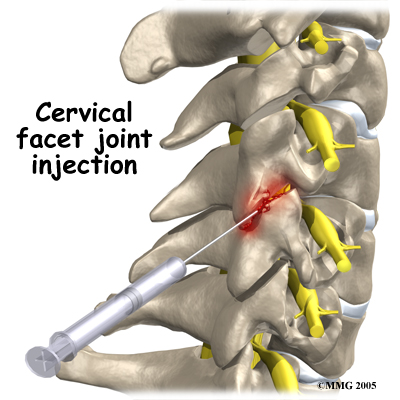Facet Joint Injection
Take the first step toward relief. Complete the form, and we’ll reach out to you for a confidential discussion about your needs.
What Are Facet Joints and Why are Facet Joint Injections Helpful?
The spine is designed to bend and turn. Along with the intervertebral discs, facet joints (also referred to as Z joints or zygapophyseal joints) enable the spine to bend and twist. Each vertebra has two sets of facet joints. One set of facet joints is located at the top and a corresponding set is at the bottom.
Facets joint are small joints a little larger than the size of your thumbnails located in pairs on the back of your spine. They provide stability and guide motion in your back. If the joints become painful they may cause pain in your neck, shoulder, low back, abdomen, buttocks, groin or legs. The pattern and location of pain helps to determine the likely facet joints involved.
Working like a hinge, the articulating surfaces of each facet joint are coated with smooth cartilage allowing friction free movement. Although the facet joint bones fit snugly together, there is a lubrication system. The lubricating ‘oil’ is called synovial fluid and resembles uncooked egg whites. This fluid also nourishes the cartilage tissues. A block that is performed to confirm that a facet joint is the source of pain and decrease pain and inflammation in a facet joint or joints.

I. Introduction
- The Facet Joint injection (FJI) procedure targets the facet joint thought to be responsible for a patient’s back pain. The joint is injected and anesthetized with the intent of relieving this pain.
- The facet injection procedure delivers a low volume of concentrated medication directly into the affected joint.
- Back Pain is often multifactorial and difficult to diagnose because the symptoms overlap considerably with those of other degenerative disorders of the spine.
- The FJI is useful in both the diagnosis and the treatment of back pain; therefore, it is both a diagnostic as well as a therapeutic procedure. In other words, if we inject a medication within the suspected joint space and the pain improves, we are fairly confident that this joint is responsible for the pain; conversely, if we inject a medication and the pain is no better, this implies that this joint is likely not responsible for the pain.

II. The Facet Joints
- The Facet Joints are the joints of the spine (cervical, thoracic, and lumbar). They contain joint fluid and are lined by cartilage. There are two facet joints at each level of the spine, one on the right and one on the left.
- The function of the facet joints of the spine is to allow movement (flexion, extension, bending side-to-side) and rotation.
- Like any other joint in the body, facet joints can become diseased, and thereby become painful.
- By far the most common disease affecting the facet joints is arthritis. This is a degenerative, inflammatory condition that over time results in loss of joint cartilage, bone overgrowth (‘osteophytes’ or ‘spurs’), erosions of the joint, and ultimately instability of the joint itself. Facet joints are also damaged by trauma, and frequently are the source of pain after whiplash type injuries. Facet injury can also occur with disc height loss, in front of the disc.
- The facet joints and their surrounding tissues are lined with nerves. As this degenerative, inflammatory condition progresses, the nerve endings become irritated and inflamed; this produces the sensation of pain. Any and all of this degenerative process may be painful.
- The primary role for imaging studies prior to the procedure is to evaluate for other possible causes of back pain.
III. Facetogenic Pain (‘Facet Syndrome’)
Just as imaging studies demonstrate typical patterns of facet joint degeneration, patients with facetogenic pain often have a typical history and physical examination suggestive of this disease. This is sometimes referred to as “Facet Syndrome”. The exact definition and what constitutes the ‘Facet Syndrome’ is somewhat controversial, but includes the following:
Cervical
- Unilateral or bilateral neck pain
- Decreased range of motion
- Tenderness over the affected facet joint(s)
- Headaches
- ‘Referred’ pain, or pain which is referred to other areas, such as the shoulder, or upper arm
Lumbar
- Unilateral or bilateral low back pain, often worsened by rest in any position
- Deep pain which may radiate to the hip, thigh and upper leg
- Pain worsened by twisting or rotation, and exacerbated by moving from sitting to standing
- Improvement of pain by standing, walking, or repeated activity
- Morning stiffness
- Pain directly over involved facet joint

Precision Relief With Facet Joint Injection
Our targeted Facet Joint Injection offers relief, bringing back the freedom to move without discomfort. Schedule a consultation.
IV. Patient Selection
- Oftentimes more than one facet joint is inflamed or degenerated. In addition, there are other factors, which may be contributing to a patient’s back pain, including disc disease, referred pain, as well as psychological factors. This can make the exact site and level responsible for the facet pain more challenging to localize and diagnose.
- Unfortunately, while imaging studies (X-RAYs, MRI and CT scans) are helpful in screening the spine for potential causes of back pain, they are often unreliable in determining whether or not a given facet joint may be the source of pain.
- They help in identifying and characterizing the extent of facet degeneration, but like any other joint in the body, the extent of degeneration doesn’t necessarily correlate with the amount of pain. In other words, some patients may show severely degenerated facet joints on imaging studies, but be relatively asymptomatic.
- Conversely, some patients experiencing severe pain from the facet joints (facetogenic pain) may show relatively mild degenerative findings on imaging studies. For this reason, the patient’s history and physical exam are very important in helping to clarify the source and level responsible for pain.
V. Procedure: Lumbar, Thoracic or Cervical Facet Joint Injection
What Will Happen To Me During The Procedure?
The procedure is explained to the patient, questions are answered and informed consent is obtained. You will be placed on the x-ray table on your stomach in such a way that your doctor can best visualize these joints in your back using x-ray guidance. The skin on your back will be scrubbed using a sterile scrub (soap). Next, the physician will numb a small area of skin with numbing medicine. This medicine stings for several seconds.
After the numbing medicine has been given time to be effective, your doctor will direct a very small needle using x-ray guidance into the joint. A small amount of contrast (dye) is then injected to insure proper needle position inside the joint space. Then, a small mixture of numbing medicine (anesthetic) and anti-inflammatory (cortisone/steroid) will be injected. One or several joints may be injected depending on the location of your usual pain.
What Will Happen After The Procedure?
Immediately after the procedure, you will get up and walk and try to imitate something that would normally bring about your usual pain. You will then report the percentage of pain relief and record the relief you experience during the next week. You should not drive the day of the procedure. Your legs may feel weak or numb for a few hours.
General Pre/Post Instructions
- You should eat a light meal within a few hours before your procedure. If you are an insulin dependent diabetic, do not change your normal eating pattern prior to the procedure. Please take your routine medications (i.e. high blood pressure and diabetic medications).
- Do not take pain medications or anti-inflammatory medications the day the day of your procedure. You need to be hurting prior to this procedure. Please do not take any medications that may give you pain relief or lessen your usual pain. These medications can be restarted after the procedure if they are needed.
- If you are on Coumadin, Heparin, Plavix or any other blood thinners (including Aspirin), or the diabetic medication Glucophage you must notify this office so the timing of these medications can be explained. You will be at the clinic for approximately 1-3 hours for your procedure.
- You will need to bring a driver with you. You may return to your normal activities the day after the procedure, including returning to work.

What If I Don’t Get Any Relief From The Facet Joint Injections?
If you don’t get relief from the facet joint injections, it is unlikely that this is a source of your pain. You should then consider with your physician the other possible sources of your pain. This may include other diagnostic blocks or imaging studies.
What Happens If I Get Relief From The Injection, But My Pain Comes Back After a Few Hours Or Days?
This is the most common scenario with facetogenic pain. Typically the local anesthetic wears off over the next six hours and the pain may return. After a series of successful diagnostic facet blocks, the next step is usually to proceed with a Radiofrequency Neurolysis (RF).
Send A Message
For questions and concerns, please fill out the form below.
Pain Conditions We Treat
At Padda Institute, our pain management specialists & pain specialist doctors provide you the guidance and treatments tailored to your needs. We are best at what we do; we diagnose and evaluate to determine your best treatment plan, so that you can experience chronic pain relief like never before.
